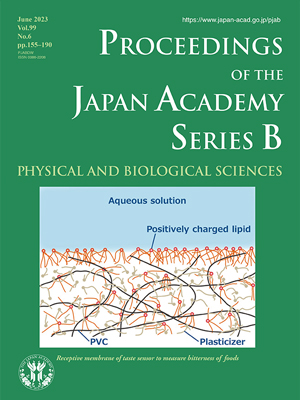About the Cover
Vol. 99 No. 6 (2023)
In the 1980s, taste was evaluated in food and pharmaceutical companies to develop "palatable food" and "easy-to-take medicines", respectively. Skilled panelists used to physically eat them to conduct the evaluation, and hence, individual differences and physical condition affect the results. Furthermore, the sensory evaluation of medicines is sometimes harmful to panelists and is not a pleasant experience. Owing to the low objectivity, low reproducibility, high training cost, and ethical problem, taste evaluation is difficult and takes time. Therefore, a novel evaluation technique that rapidly and easily provides objective results was highly desired.
Although several technologies were proposed, they were not put to practical use. Dr. Kiyoshi Toko, author of the present issue (pp. 173-189), made research on dynamic electrical properties of lipid membranes at this time, and then applied the results to the sensing of taste. In 1989, Dr. Toko et al. submitted a patent application for their taste sensor, which utilized a lipid/polymer membrane as the transducer. They adopted a development policy focused on global selectivity, which aimed to decompose the characteristics of a chemical substance into taste qualities and quantify them, rather than focusing on individual chemical discrimination, in a similar way to the human tongue. This approach differs from chemical/biosensors, which respond to a specific chemical substance on a one-to-one basis. Many types of e-tongue using different measurement methods were subsequently developed, inspired by Dr. Toko's original concept.
The commercialized taste-sensing system based on his idea uses a receptive membrane composed of a lipid, a plasticizer, and polyvinyl chloride (PVC). Multiple lipid/polymer membranes generate potential outputs, which can be easily converted into the taste intensity. More than 600 units of the system have been used, while providing the first "taste scale" in the world.
The cover figure shows the bitterness sensor membrane, which consists of PVC, tetradodecylammonium bromide (TDAB), and 2-nitrophenyl octyl ether (NPOE). This particular sensor is specifically designed to measure the bitterness of food compounds. The TDAB molecule's hydrophilic group faces the water phase, while the hydrophobic group interacts with the PVC, ensuring thermodynamic stability within the membrane. The surface structure created by this arrangement is crucial in detecting taste substances.
This review explains the principle of taste sensors and their applications to foods and medicines. Additionally, it highlights a novel type of taste sensor using allostery. The taste-sensor technology, the underlying principle of which is different from that of conventional analytical instruments, markedly affects many aspects including the social economy as well as the food industry.
Hidekazu Ikezaki
Dr., President, Intelligent Sensor Technology, Inc.




